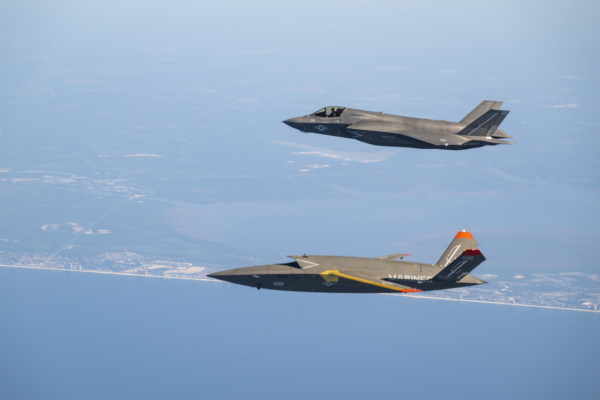In October, the United States Marine Corps successfully tested the F-35 “Lightning II” stealth fighter and an experimental unmanned “Loyal Wingman” aircraft. This test marks a significant step in the Marine Corps’ efforts to integrate manned aircraft with drones.
According to a report on the U.S. Naval Institute website on October 22, during the “Emerald Flag 2024” military exercise, the Marine Corps conducted its first joint force data link integration test. They deployed a Kratos XQ-58A “Valkyrie” unmanned aircraft, acting as a “Loyal Wingman” drone to provide target data to F-35B fighters and other aircraft.
This test was the fourth flight test of the Marine Corps’ XQ-58A “Valkyrie” and is seen as a milestone in advancing the military’s manned-unmanned teaming concept.
The XQ-58A “Valkyrie” is manufactured by Kratos Defense & Security Solutions and is an experimental stealth unmanned combat aerial vehicle designed to collect data and provide reconnaissance information to partner aircraft, offering additional combat options.
Ordered by the Marine Corps at the end of 2022, the XQ-58A “Valkyrie” drones serve as sensor platforms, collecting target data and relaying it to fifth-generation aircraft such as the F-35B and F-35C, representing the Marine Corps’ most sophisticated and latest aviation assets.
Measuring 30 feet in length with a wingspan of 27 feet, the XQ-58A has an empty weight of 1134 kilograms and a maximum takeoff weight of 2722 kilograms. It has a cruise speed of 882 kilometers per hour, a range of approximately 5600 kilometers, and a service ceiling of 45,000 feet.
Equipped with AI-driven autonomous capabilities, the XQ-58A significantly enhances the aircraft’s precision and rapid decision-making abilities. AI serves as a core component of the aircraft, seamlessly integrating into complex aerial operations, cost-effectiveness, and adapting to future air combat requirements.
This aircraft is crafted as a low-cost, high-performance unmanned vehicle intended to support manned aircraft in executing various missions, especially in air-to-air and air-to-ground combat scenarios, acting as a “Loyal Wingman” to more expensive manned platforms like the F-22 or F-35 fighters.
The Marine Corps’ “Valkyrie” drone conducted its maiden flight last year. Following flight tests in February and September this year, with the September test preparing for the “Emerald Flag 2024” data link integration test.
The Marine Corps stated that during the “Emerald Flag 2024” exercise at Eglin Air Force Base in Florida this month, the XQ-58A “effectively showcased its capability as a cutting-edge sensor platform, providing crucial threat target data for Marine Corps’ fifth-generation fighters, greatly accelerating the establishment of advanced kill chains and response speed.”
Colonel Derek Brannon, head of the Cunningham Team under the Deputy Commander’s Office of the Air Forces, explained that the recent test “marks another milestone in the Marine Corps’ unmanned tactical aircraft program.” The “Valkyrie” established connections with four F-35B fighters and other aircraft and ground participants through tactical data links and digital communications during the flight.
The F-35 is a fifth-generation stealth fighter manufactured by Lockheed Martin, designed to be the quarterback of U.S. combat power.
Brannon stated in a release, “The success of this flight test during the Emerald Flag exercise pushes forward the progress of the entire joint force manned-unmanned teaming concept.”
The U.S. Marine Corps statement added, “Through this successful joint integration, the XQ-58A continues to provide a valuable testing platform for the Marine Corps to integrate new technologies and concepts to support the unmanned expeditionary tactical aircraft program of the Marine Corps’ air-ground task forces.”
The U.S. Army Corps of Engineers indicated that the focus of the “Emerald Flag” exercise is testing emerging technologies from various military fields, including “integrated advanced kill chains.” The unit expressed that these efforts would be implemented through a series of realistic combat training environments in the air, space, and network spaces.

